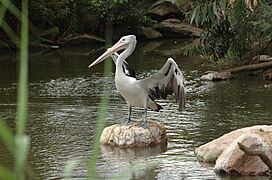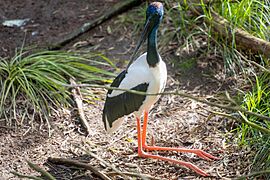Melbourne Zoo facts for kids
 |
|

Main Entrance
|
|
| Date opened | 6 October 1862 |
|---|---|
| Location | Parkville, Melbourne, Victoria, Australia |
| Land area | 55 acres (22 ha) |
| Coordinates | 37°47′05″S 144°57′08″E / 37.784762°S 144.952095°E |
| No. of animals | 5,120 |
| No. of species | 250 |
| Memberships | Zoo and Aquarium Association, World Association of Zoos and Aquariums |
| Major exhibits | lions, tigers, snow leopards, orang-utans, gorillas, gibbons, baboons, lemurs, pygmy hippopotamus, giraffes, marsupials, platypus, birds, reptiles |
The Melbourne Zoo is a fantastic place to visit in Melbourne, Australia. It is located in Parkville, about 4 kilometers north of the city center. This zoo is the main one for Melbourne.
As of 2021, the zoo was home to 3,742 animals. These animals represented 243 different species. They came from Australia and all over the world. You can easily get to the zoo by train, tram, or bicycle. Just remember, bikes are not allowed inside the zoo itself!
Melbourne Zoo is a proud member of important groups. These include the Zoo and Aquarium Association and the World Association of Zoos and Aquariums.
The zoo is filled with beautiful flower gardens and picnic spots. Many animals live in special areas called "bioclimatic zones." These zones are designed to look like the animals' natural homes. For example, there is an African rainforest area with gorillas and lemurs. An Asian rainforest section has orangutans, tigers, and otters. The Australian bush area features kangaroos, koalas, wombats, and many native birds.
Other popular spots include the 'Butterfly House' and the 'Reptile House'. Don't miss the 'Great Flight Aviary' or 'Wild Sea'. You can also see 'Treetop Apes and Monkeys' and 'Lion Gorge'. During summer, the zoo even hosts "Roar and Snore" sleepovers. You can camp out under the stars and see some nocturnal animals!
The zoo has a big section just for schools. Many students visit each year. Its popular education program helps young people learn about animal conservation. Visitors can also see old cages, like the historic Elephant House. This building has been updated for guests who stay overnight during the "Roar and Snore" events.
Contents
History of Melbourne Zoo
How the Zoo Started
In October 1857, a group called the Zoological Society of Victoria was formed. Their goal was to bring new animals and plants from other countries to Australia. Their first animal collection was kept in Richmond Paddock. In 1861, the group changed its name to the "Acclimatisation Society of Victoria."
On October 6, 1862, the society opened the new Melbourne Zoo. It was built in Royal Park on 55 acres of land. The City of Melbourne donated this land. Melbourne Zoo was designed to be like the famous London Zoo.
Growing and Changing
At first, the zoo helped domestic animals recover after their long journey to Australia. But in 1870, Albert Alexander Cochrane Le Souef became the director. He started bringing in more exotic animals for people to see. The gardens and picnic areas also grew. In 1870, the society changed its name again to the "Zoological and Acclimatisation Society of Victoria." In 1910, it was given the special title "Royal."
One of the most famous animals from the early 1900s was Queenie the elephant. She was a very popular exhibit until the 1940s.
In the mid-1930s, the zoo faced money problems. To help, the government passed a law called the Zoological Gardens Act 1936. This law gave the zoo to a new group, the Zoological Board of Victoria, in 1937.
In 1964, the amazing Lion Park exhibit opened. It had a raised walkway where visitors could look down at two separate lion areas. This exhibit was replaced by a new lion area in 2014.
Australia's first gorilla baby was born at Melbourne Zoo in 1984. In 1988, giant pandas came to the zoo from China. This was a special exhibition to celebrate Australia's 200th birthday.
Recent Developments
The 'Trail of the Elephants' exhibit opened in 2003. It won many awards. On January 15, 2010, Melbourne Zoo welcomed its first elephant calf, Mali. She was the first female elephant calf born in Australia. Mali was also the first calf born through artificial insemination in Australia.
In February 2025, the zoo's elephant herd moved to its sister zoo, Werribee Open Range Zoo. They now live in a new, large 21-hectare home. The 'Trail of the Elephants' area at Melbourne Zoo was then renamed 'Forest of Wonder'.
Melbourne Zoo celebrated 150 years of being open in 2012. Australia Post even released special collector's stamps to mark the occasion. The zoo also finished building a new carnivores trail in early 2018.
Zoos Victoria Family
Zoos Victoria manages Melbourne Zoo. It also looks after two other amazing places:
- The Werribee Open Range Zoo: This zoo features herbivorous animals like giraffes and rhinos. They live in a wide-open, natural setting.
- Healesville Sanctuary: This sanctuary, once called the Sir Colin MacKenzie Sanctuary, shows off Australian fauna. It is set on 175 hectares of bushland.
These three zoos have been working together as Zoos Victoria since 1973. They are run by the Zoological Parks and Gardens Board. This board operates under the Zoological Parks and Gardens Act 1995.
In July 2022, Kyabram Fauna Park also joined the Zoos Victoria family. In October 2023, Colossal Biosciences and Zoos Victoria started a project. They are working to protect the Victorian Grassland Earless Dragon. They are also studying its genetic information.
The Carousel
The beautiful carousel at Melbourne Zoo was made in England. It came to Australia in 1886 with a family who ran a traveling carnival. For over 60 years, it visited country towns in Victoria. In 1952, the carousel became part of a fun fair at Melbourne Zoo. However, it was still owned by the same families.
When the fun fair closed permanently in 1997, the zoo bought the carousel. By then, it was in poor condition. It was carefully restored between 2004 and 2005. Heritage Victoria helped with the funding. The carousel reopened in August 2005. It is now listed as a heritage place by Heritage Victoria.
Animal Exhibits
Gorilla Rainforest
This area is home to amazing primates and reptiles.
Growing Wild
Discover a variety of creatures, from giant tortoises to tiny frogs.
- Aldabra giant tortoise
- Blue-and-yellow macaw
- Central bearded dragon
- Centralian blue-tongued lizard
- Chameleon gecko
- Fijian crested iguana
- Komodo dragon
- Meerkat
- Northern banded knob-tailed gecko
- Red-tailed black cockatoo
- Scheltopusik
- Southern corroboree frog
- Victorian grassland earless dragon
Forest of Wonder
This area was once the 'Trail of the Elephants'. It now features other Asian animals.
- Asian small-clawed otter
- Black-winged stilt
- Bolivian squirrel monkey
- Luzon bleeding-heart dove
- Noisy pitta
- Rose-crowned fruit dove
- Sacred kingfisher
- Siamang
- Sumatran orangutan
- Sumatran tiger
- The zoo's butterfly house (opened in 1985) is also here.
Wild Sea
Explore marine life from Australia's coasts.
- Australian fur seal
- Eastern fiddler ray
- Little penguin
- Long-nosed fur seal
- Port Jackson shark
Australian Bush
Meet iconic Australian animals in their natural-looking habitat.
Great Flight Aviary
Walk through a large aviary filled with many bird species.
- Black-faced cormorant
- Black-necked stork
- Blue-billed duck
- Blue-faced honeyeater
- Brown-capped emerald dove
- Buff-banded rail
- Bush stone curlew
- Cattle egret
- Freckled duck
- Glossy ibis
- Little pied cormorant
- Nicobar pigeon
- Pied heron
- Pied imperial pigeon
- Pink cockatoo
- Radjah shelduck
- Royal spoonbill
- Satin bowerbird
- Southern cassowary
- White-faced heron
- White-headed stilt
Lion Gorge
See powerful predators and other fascinating animals.
DigestED
Learn about different types of snakes and frogs.
- Ball python
- Blood python
- Macleay’s water snake
- Magnificent tree frog
- Reticulated python
World of Frogs
Discover many unique frog species.
Reptile House
A home for many different reptiles from around the world.
- Black-headed python
- Blood python
- Broad-headed snake
- Canberra grassland dragon
- Cantil
- Central netted dragon
- Centralian knob-tailed gecko
- Coastal taipan
- Common death adder
- Corn snake
- Eastern diamondback rattlesnake
- Elongated tortoise
- Eyelash viper
- Fiji crested iguana
- Freshwater crocodile
- Frill-necked lizard
- Gila monster
- Golden coin turtle
- Hosmer's skink
- Indian star tortoise
- Jungle carpet python
- Monocled cobra
- Philippine crocodile
- Plumed basilisk
- Pueblan milk snake
- Rainbow boa
- Red-barred dragon
- Rhinoceros iguana
- Scheltopusik
- Shingleback lizard
- Short-finned eel
- Spiny terrapin
- Striped legless lizard
- Sunda king cobra
- Tiger snake
- Tokay gecko
- Twist-necked turtle
- Veiled chameleon
Main Trail
Animals you might see along the main paths of the zoo.
Gallery
See also





























